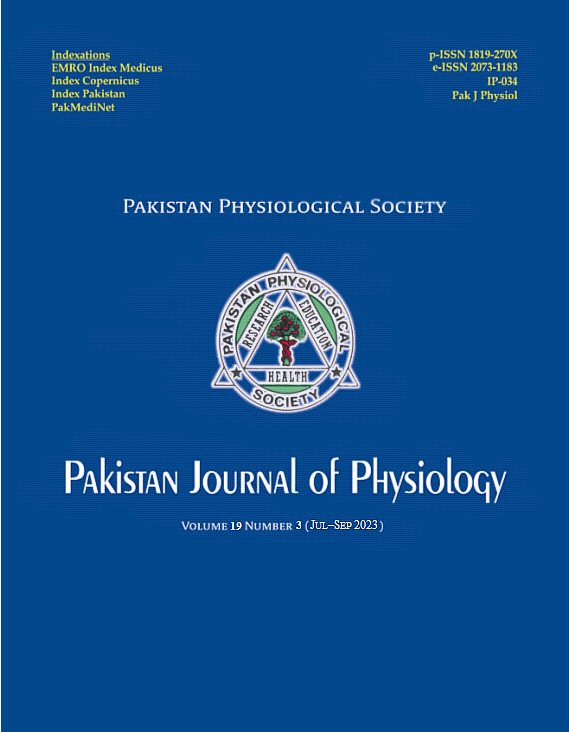PERCEPTION OF FIRST-YEAR MEDICAL STUDENTS REGARDING SELF-DIRECTED LEARNING AND CONVENTIONAL LECTURING IN PHYSIOLOGY THROUGH ACTIVITY FEEDBACK
DOI:
https://doi.org/10.69656/pjp.v19i3.1534Keywords:
Self-directed learning, critical reflection, Medical education, problem based learning, Conventional teaching, Physiology teachingAbstract
Background: In order to transform the healthcare professionals into lifelong learners, it is important to develop self-directed learning (SDL) skills in their early study years. Students engaged in SDL can complete their learning assignments and can be transformed into lifelong learners. The objective of this study was to evaluate the improvements in perception of students by integrating principles of SDL activity in conventional curricular system in a 4-week first-year MBBS respiratory module. Methods: It was a descriptive cross-sectional survey conducted in Ayub Medical College Abbottabad on First Year MBBS (2020–2021) batch, where the module coordinator assigned respiratory insufficiency case-based studies to 1st Year medical students. Students were asked to give response to 20 questions on standard questionnaire proforma. Students were asked to reflect on how this assignment affected their perception of SDL skills and improvement in learning. Students strongly agreed, agreed, neither agree nor disagree, disagree, and strongly disagree about the 20 responses on Likert scale. For simplification, descriptive parameters were modified to numerical values which were then used to analyze responses on MS Excel. Results: Feedback response rate was 80% (177, 99 males and 78 females). Frequency of responses was recorded both for conventional teaching (CT) and SDL. There was marked variation in responses, both for SDL and conventional method of teaching. Conclusions: The students positively perceived the activity as a valuable learning experience. SDL assignments can be successfully implemented in pre-clinical courses and show improvements in their perception and learning skills.
Pak J Physiol 2023;19(3):46–50
Downloads
References
Sawatsky AP, Ratelle JT, Bonnes SL, Egginton JS, Beckman TJ. A model of self-directed learning in medicine residency: a qualitative study using grounded theory. BMC Med Educ 2017;17(31).
Khiat H. Academic performance and the practice of self-directed learning: the adult student perspective. J Furth High Educ 2017;41(1):44–59.
Kidane HH, Roebertsen H, van der Vleuten CPM. Students’ perceptions towards self-directed learning in Ethiopian medical schools with new innovative curriculum: a mixed-method study. BMC Med Educ 2020;20(1):7.
Bhandari B, Chopra D, Singh K. Self-directed learning: assessment of students’ abilities and their perspective. Adv Physiol Educ 2020;44(3):383–6.
du Toit-Brits C. A focus on self-directed learning: The role that educator’ expectations play in the enhancement of students’ self-directedness. South African J Educ 2019;39(2),1–11.
Robinson JD, Persky AM. Developing self-directed learners. Am J Pharm Educ 2020;84(3):847512.
Kaulback MK. Correlating self-directed learning abilities to lifelong learning orientation in Baccalaureate nursing students. Nurse Educ 2020;45(6):347–51.
Tekkol ?A, Demirel M. An investigation of self-directed learning skills of undergraduate students. Front Psychol 2018;9:2324.
Kerr D, Ratcliff J, Tabb L, Walter R. Undergraduate nursing student perceptions of directed self-guidance in a learning laboratory: an educational strategy to enhance confidence and workplace readiness. Nurse Educ Pract 2020;42:102669.
Hill M, Peters M, Salvaggio M, Vinnedge J, Darden A. Implementation and evaluation of a self-directed learning activity for first-year medical students. Med Educ Online 2020;25(1):1717780.
Jeong D, Presseau J, ElChamaa R, Naumann DN, Mascaro C, Luconi F, et al. Barriers and facilitators to self-directed learning in continuing professional development for physicians in Canada: a scoping review. Acad Med 2018;93(8):1245–54.
Ananthakrishnan N. Competency based undergraduate curriculum for the Indian medical graduate, the new MCI curricular document: positives and areas of concern. J Basic Clin Appl Health Sci 2018;1(1):34–42.
Yang C, Zhu Y, Jiang H, Qu B. Influencing factors of self-directed learning abilities of medical students of mainland China: a cross-sectional study. BMJ Open 2021;11(10):e051590.
Galvin E, Wiese A, Dahly D, O’Farrell J, Cotter J, Bennett D. Maintenance of professional competence in Ireland: a national survey of doctors’ attitudes and experiences. BMJ Open 2020;10(12):e042183.
Leatemia LD, Susilo AP, van Berkel H. Self-directed learning readiness of Asian students: Student’s perspective on a hybrid problem based learning curriculum. Int J Med Educ 2016;7:385–92.
State Council General Office of China. Guidelines on accelerating the innovative development of medical education of the State Council General Office, 2020. Available: http://www.gov.cn/ zhengce/content/2020-09/23/content_5546373.htm
Uus O, Mettis K, Valjataga T. Self-directed learning: A case-study of school students’ scientific knowledge construction outdoors. Cogent Educ 2022;9(1):2074342.
De Bruin ABH, Van Merriënboer JJG. Bridging cognitive load and self-regulated learning research: A complementary approach to contemporary issues in educational research. Learn Instr 2017;51:1–9.
Du Toit-Brits, C. Towards a transformative and holistic continuing self-directed learning theory. South Afr J High Educ 2018;32(4):51–65.
Schweder S, Raufelder D. Positive emotions, learning behavior and teacher support in self-directed learning during adolescence: Do age and gender matter? J Adolesc 2019;73:73–84.
Du Toit-Brits, C. Unleashing the power of self-directed learning: criteria for structuring self-directed learning within the learning environments of higher education institutions. Afr Educ Rev 2020;17(2):20–32.
Briggs S. 20 Steps towards more self-directed learning. (Online). Available at: www.opencolleges.edu.au/informed/features/29-steps-toward-more-selfdirected-learning/ [Acceded on: 5 Aug 2019].
Cadorin L, Bressan V, Palese A. Instruments evaluating the self-directed learning abilities among nursing students and nurses: a systematic review of psychometric properties. BMC Med Educ 2017;17(1):229.
Premkumar K, Vinod E, Sathishkumar S, Pulimood AB, Umaefulam V, Prasanna Samuel P, et al. Self-directed learning readiness of Indian medical students: a mixed method study. BMC Med Educ 2018;8(1):134.
Dost S, Hossain A, Shehab M, Abdelwahed A, Al-Nusair L. Perceptions of medical students towards online teaching during the COVID-19 pandemic: a national cross-sectional survey of 2,721 UK medical students. BMJ Open 2020;10:e042378.
Downloads
Published
How to Cite
Issue
Section
License

This work is licensed under a Creative Commons Attribution-NoDerivatives 4.0 International License.
The author(s) retain the copyrights and allow their publication in Pakistan Journal of Physiology, Pak J Physiol, PJP to be FREE for research and academic purposes. It can be downloaded and stored, printed, presented, projected, cited and quoted with full reference of, and acknowledgement to the author(s) and the PJP. The contents are published with an international CC-BY-ND-4.0 License.











